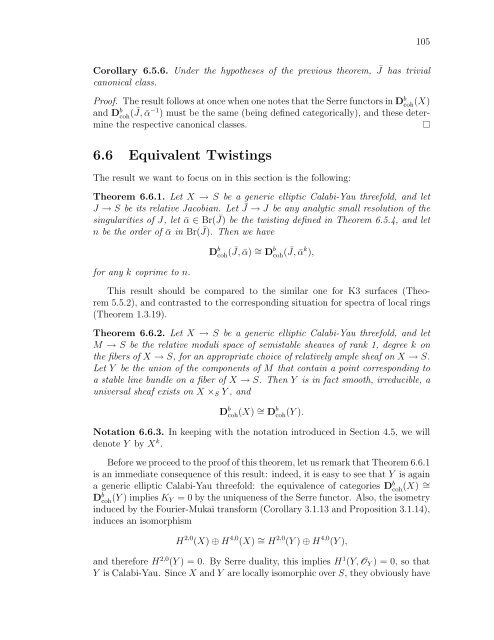derived categories of twisted sheaves on calabi-yau manifolds
derived categories of twisted sheaves on calabi-yau manifolds
derived categories of twisted sheaves on calabi-yau manifolds
You also want an ePaper? Increase the reach of your titles
YUMPU automatically turns print PDFs into web optimized ePapers that Google loves.
Corollary 6.5.6. Under the hypotheses <str<strong>on</strong>g>of</str<strong>on</strong>g> the previous theorem, ¯ J has trivial<br />
can<strong>on</strong>ical class.<br />
105<br />
Pro<str<strong>on</strong>g>of</str<strong>on</strong>g>. The result follows at <strong>on</strong>ce when <strong>on</strong>e notes that the Serre functors in D b coh (X)<br />
and D b coh ( ¯ J, ¯α −1 ) must be the same (being defined categorically), and these determine<br />
the respective can<strong>on</strong>ical classes.<br />
6.6 Equivalent Twistings<br />
The result we want to focus <strong>on</strong> in this secti<strong>on</strong> is the following:<br />
Theorem 6.6.1. Let X → S be a generic elliptic Calabi-Yau threefold, and let<br />
J → S be its relative Jacobian. Let ¯ J → J be any analytic small resoluti<strong>on</strong> <str<strong>on</strong>g>of</str<strong>on</strong>g> the<br />
singularities <str<strong>on</strong>g>of</str<strong>on</strong>g> J, let ¯α ∈ Br( ¯ J) be the twisting defined in Theorem 6.5.4, and let<br />
n be the order <str<strong>on</strong>g>of</str<strong>on</strong>g> ¯α in Br( ¯ J). Then we have<br />
for any k coprime to n.<br />
D b coh( ¯ J, ¯α) ∼ = D b coh( ¯ J, ¯α k ),<br />
This result should be compared to the similar <strong>on</strong>e for K3 surfaces (Theorem<br />
5.5.2), and c<strong>on</strong>trasted to the corresp<strong>on</strong>ding situati<strong>on</strong> for spectra <str<strong>on</strong>g>of</str<strong>on</strong>g> local rings<br />
(Theorem 1.3.19).<br />
Theorem 6.6.2. Let X → S be a generic elliptic Calabi-Yau threefold, and let<br />
M → S be the relative moduli space <str<strong>on</strong>g>of</str<strong>on</strong>g> semistable <str<strong>on</strong>g>sheaves</str<strong>on</strong>g> <str<strong>on</strong>g>of</str<strong>on</strong>g> rank 1, degree k <strong>on</strong><br />
the fibers <str<strong>on</strong>g>of</str<strong>on</strong>g> X → S, for an appropriate choice <str<strong>on</strong>g>of</str<strong>on</strong>g> relatively ample sheaf <strong>on</strong> X → S.<br />
Let Y be the uni<strong>on</strong> <str<strong>on</strong>g>of</str<strong>on</strong>g> the comp<strong>on</strong>ents <str<strong>on</strong>g>of</str<strong>on</strong>g> M that c<strong>on</strong>tain a point corresp<strong>on</strong>ding to<br />
a stable line bundle <strong>on</strong> a fiber <str<strong>on</strong>g>of</str<strong>on</strong>g> X → S. Then Y is in fact smooth, irreducible, a<br />
universal sheaf exists <strong>on</strong> X ×S Y , and<br />
D b coh(X) ∼ = D b coh(Y ).<br />
Notati<strong>on</strong> 6.6.3. In keeping with the notati<strong>on</strong> introduced in Secti<strong>on</strong> 4.5, we will<br />
denote Y by X k .<br />
Before we proceed to the pro<str<strong>on</strong>g>of</str<strong>on</strong>g> <str<strong>on</strong>g>of</str<strong>on</strong>g> this theorem, let us remark that Theorem 6.6.1<br />
is an immediate c<strong>on</strong>sequence <str<strong>on</strong>g>of</str<strong>on</strong>g> this result: indeed, it is easy to see that Y is again<br />
a generic elliptic Calabi-Yau threefold: the equivalence <str<strong>on</strong>g>of</str<strong>on</strong>g> <str<strong>on</strong>g>categories</str<strong>on</strong>g> D b coh (X) ∼ =<br />
D b coh (Y ) implies KY = 0 by the uniqueness <str<strong>on</strong>g>of</str<strong>on</strong>g> the Serre functor. Also, the isometry<br />
induced by the Fourier-Mukai transform (Corollary 3.1.13 and Propositi<strong>on</strong> 3.1.14),<br />
induces an isomorphism<br />
H 2,0 (X) ⊕ H 4,0 (X) ∼ = H 2,0 (Y ) ⊕ H 4,0 (Y ),<br />
and therefore H 2,0 (Y ) = 0. By Serre duality, this implies H 1 (Y, OY ) = 0, so that<br />
Y is Calabi-Yau. Since X and Y are locally isomorphic over S, they obviously have
















